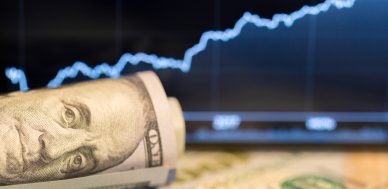The Dollar Rising Fast Could Create Problems
The U.S. dollar has made a robust rise recently. This could be saying economic troubles are brewing that could bring a lot of pain to investors’ portfolios.
The fundamentals of the U.S. dollar are tormented, to say the least. The U.S. government has amassed a significant amount of debt that’s only expected to grow, the economy isn’t doing that great, there’s a lot of political uncertainty, and there’s been an emergence of new currencies. Despite all this, the greenback keeps on rising.
Year-to-date, the U.S. Dollar Index, which tracks the performance of the dollar relative to other major currencies, is up by close to 11%. In the past year, the index has spiked by close to 15%. Since the beginning of 2021, the U.S. Dollar Index has surged by 17%. The last time the index was this high was around 2003.
For some perspective, look at the following chart.
Chart courtesy of StockCharts.com
Why the U.S. Dollar Matters
The U.S. dollar has a reserve status in the global economy. One could even call it the “king of all currencies.” The vast majority of global trade is done in dollar terms, commodities are priced in dollars, central banks around the world hold dollars in their foreign exchange reserves, and a lot of debt globally is denominated in U.S. dollars.
Also, historically speaking, the U.S. dollar has acted as a safe-haven asset. The dollar has a history of holding value better than other fiat currencies, so investors rush to buy it as soon as they fear that something bad is brewing in the economy.
Furthermore, the earnings of U.S. public companies with global operations are affected when the value of the U.S. dollar fluctuates. As the dollar increases in value, even if those companies’ sales levels remain the same, the value of their sales will decline, which ultimately hurts the companies’ overall earnings.
Moreover, a higher U.S. dollar hurts U.S. exporters. As the value of the dollar goes up, the demand for their goods and services becomes weaker.
What the Rising of the Dollar Is Telling Us
There are many economic problems happening around the globe these days. Europe is going through various problems, China has problems with housing and business activity slowing, emerging economies are struggling with soaring inflation, and the list of issues keeps getting longer.
Given all that’s happening, the dollar increasing in value says there’s a flight toward safety. Investors, businesses, and governments could be buying U.S. dollars to protect themselves from some sort of a currency crunch.
There’s one more thing, and it might sound like an obscene idea, given how much money has been printed over the past few years by the Federal Reserve. The rising dollar also means there could be dollar shortages globally. If a dollar shortage becomes a real thing, could it mean some sort of financial crisis is upon us?
In addition to all this, companies’ earnings could get hurt. Don’t be shocked if, in the coming quarters, companies are reporting “currency-adjusted” earnings in addition to their usual earnings figures.
Lastly, exports directly affect the gross domestic product (GDP) of the U.S. economy. In the second quarter of 2022, the annualized rate of exports of goods and services from the U.S. stood at almost $3.0 trillion. (Source: “Exports of Goods and Services,” Federal Reserve Bank of St. Louis, last accessed August 1, 2022.)
A soaring dollar could certainly affect these export figures, which would eventually show up in U.S. GDP figures.
Outlook for the U.S. Dollar
Dear reader, as I see it, the rising U.S. dollar is one of the most underreported stories in the media these days.
As it stands, I don’t think the dollar is done going up just yet. I wouldn’t be surprised if the U.S. Dollar Index tests its 2001 high of around 120. I believe there’s more upside for the dollar for three big reasons.
First, with currencies, trends tend to remain in place for a long time. Currently, the U.S. dollar is trending higher.
Second, a rising dollar essentially scares those with a significant amount of dollar-denominated debt. They have to pay interest in U.S. dollars, so the higher the dollar goes, the more they have to pay to service their debt. So, wouldn’t they want to buy U.S. dollars now?
Just so you know, as of the third quarter of 2021, $13.4 trillion worth of dollar-denominated debt was held outside of the U.S. by non-bank borrowers. (Source: “Total Credit to Non-Bank Borrowers by Currency of Denomination: US Dollar,” Bank for International Settlements, last accessed August 1, 2022.)
Third, the troubles in the global economy continue, and chances are low that the conditions will get better instantly. It will take time, which could continue to be a reason for investors, businesses, and others to buy U.S. dollars.
I will end with this: the higher the dollar goes, the bigger the economic problems will get. Investors should be very careful. This could have dire impacts on their portfolios. For a brief period, it might be fine for the U.S. economy, but it will continue to hurt the global economy and eventually come back to hurt the U.S. economy and financial market.
